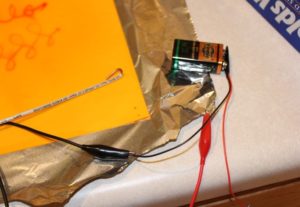 by Nancy Foote
by Nancy Foote
I’m in love with goldenrod paper. I’ve loved it for a long time. In my never-ending quest to emotionally entangle my students in the content of our science curriculum, Color-Changing Goldenrod Paper provides a long-lasting entanglement.
If you’ve never done the bloody handprint goldenrod paper demo with your students, you are truly missing out—and so are they)! This is the most engaging “engage” part of the 5 E’s I’ve ever experienced. I like to do the bloody handprint demo around Halloween, but we don’t do acid/base chemistry until February. That’s a long time to wonder, ponder and try to figure out exactly what is happening. But that’s for another blog post.
A Goldenrod Surprise!
My friends at Educational Innovations sent my class a Goldenrod Electrochemistry Kit. I couldn’t wait to see how my students reacted to this!
I put the following items into a container on my Curiosity Table: 1 sheet of goldenrod paper, a container of household table salt, a sheet of aluminum foil, a 9-volt battery, a wire probe and some wire with alligator clips.
I also gave my students the following instructions:
- Make a supersaturated solution of salt and warm water.
- Dip the entire goldenrod sheet into the salt solution.
- Spread out the goldenrod paper on the aluminum foil.
- Connect the positive side of the battery to the aluminum foil.
- Connect the negative side of the battery to the metal probe.
- Write on the goldenrod paper with the metal probe.
To say that my students were amazed would be a vast understatement. The noise level went up exponentially. I could feel the energy in the room increase. They were emotionally entangled – just as I’d hoped.
They began to investigate. If the paper was wetter, what would happen to the color?
Conversely, how does the color look on the drier parts of the paper?
If you held the metal probe to one spot, how would the imprint change?
Why does the water change colors when you dip the paper into it? Can you make the water change color?
What happens when the paper dries? Is the red permanent? (The answer is no because the pH reverts back to its original level and goldenrod paper is, after all, an acid-base indicator.)
But perhaps my favorite question was “Can I try it next?”
We decided to use the Goldenrod Electrochemistry Kit as we went over the current learning opportunity. When it was your turn to answer, you got to write your answer on the goldenrod paper and hold it up for all to see. While going over in-class assignments is sometimes tedious, this made my students clamor for a chance to answer. The entire atmosphere of the classroom changed—you could say it was electrified.
The science behind this is simply the electrolysis of water. We’re not at the point in our curriculum when discussing the electrolysis of water is appropriate, but when we get there, everyone will remember this experience.
If you are looking for a low-cost, high-engagement way to introduce some inquiry-based learning into your classroom, the Goldenrod Electrochemistry Kit is the way to do it. Educational Innovations has tons of chemistry science experiments to keep your students engaged. Give your students permission and encouragement to find out whatever they want about this chemistry marvel.
This is the perfect, inexpensive tool for emotional entanglement. Thanks, Educational Innovations, for the curiosity!
Nancy Foote is a middle school physics teacher in Arizona. She is a recipient of the Presidential Award for Excellence in Mathematics and Science Teaching, as well as an Arizona master teacher. Nancy’s YouTube channel can be found at www.YouTube.com/nancyfootehigley.




